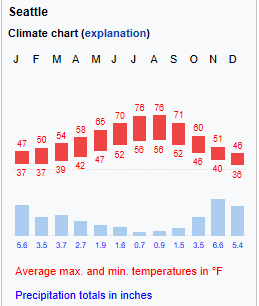California Weather Comes to Seattle
August 5, 2017
by William P. Meyers
Also sponsored by Earth Pendant at PeacefulJewelry
Popular pages:
| U.S. War Against Asia |
| Fascism |
| Democratic Party |
| Republican Party |
| Natural Liberation |
No rain since mid-June
It is not going to rain today. It has not rained since mid-June. On August 7, Monday, we will tie the record number of consecutive rainless days in Seattle at 51. There is no rain in the forecast at least through the thirteenth, so we are highly likely to crush the old record.
Weather varies. But it usually varies within envelopes. Seattle traditionally has rainy winters and only moderate rain during summers. Here's a chart I stole from Wikipedia:

As you can see, on average Seattle has not received a great deal of rain in June, July, or August in the past. But it does rain, and that helps keep the city green.
This is a less extreme version of the typical weather pattern in coastal northern California. Yes, I note that Seattle is actually not coastal, but is on Puget Sound, behind the mighty Olympic Peninsula.
In San Francisco, for instance, the average rainfall in June, July, and August rounds to zero. A May without rain, or a September without rain, is not unusual.
The pattern of increasingly dry summers runs from north to south. To simplify, for much of coastal California, the usually totally dry season runs from June 1 to September 31. Sometimes longer.
So, while the current Seattle drought might be a one-time affair, or something we might see again in a few years, it may be part of a long-term pattern. The California pattern.
The change is that arid summers are moving north up the Pacific coast of America. The climate of northern California is heading to Oregon and even Washington. The climate of southern California is heading to northern California.
I lived near Point Arena California for over 20 years, and got used to the pattern. Summers were bone dry, so dry that often even some of the native plants died. Around October you could start hoping for rain. Sometimes substantial rain did not come until December. Some times the rain lasted into May, but usually if you wanted to plan an outdoor activity in May, your chances of staying dry were very good.
The cause of the change is certainly global warming. It is a slow process, against a background of variability, so we could have a better rain year, or summer, in 2018 than we are having in 2017. Then again, we may never see another wet summer in Seattle.
A lot of things will change if we start having totally dry summers, and more if the rainless periods creep into the May to September period. The native plants are not set up for this. Looking out my window, I can see a fir tree that has leaves turning brown. Sure, I could go out and water it, I probably will. But no one is going to water the extensive forests in the Seattle area. They will wilt and lose leaves and eventually die. A fire will then wipe out the old species. New, drought tolerant plants of the type that grow in Oregon or California will eventually replace them.
And Seattle itself will become a fire hazard. There are a lot of trees, and most of the houses are wood. Activists won't want the trees cut. Laws are already in place making it difficult to remove trees. That will change only after the first big multi-block fire fueled by dry trees.
Seattle pretends to be a progressive city. It is building more light rail in order to move people around more efficiently. Cars jam its streets. People are buying more air conditioners now that it is getting hot more often. No one wants to contribute to climate change, but no one wants to be uncomfortable, either.
